Justin has previously written about the challenges faced by RevolverGuys who actually want to carry revolvers as defensive arms, and one of the more frustrating aspects of doing this is finding a good way to carry a round-body speedloader.
Reload Carry
The fact is, there’s a dearth of good pouches for speedloaders out there, which leads many RevolverGuys to take one of three less than satisfactory approaches: Throw it into the pocket, loose; Trade it for an easier-to-pocket strip loader, or; Skip carrying any spare ammo at all.
The last option is to be avoided for obvious reasons. If you’re carrying a gun for defense—and especially one that’s capacity-limited to begin with—then you should carry at least one reload for it, if for no other reason than it will make you feel a lot better if you can bring your gun up to full capacity in the interval between the end of shooting and the arrival of the cavalry.
Carrying a loose speedloader in the pocket is fraught with difficulties. There’s not much protection for the loader and its payload, so they can get damaged or plugged with debris, and the loader can discharge by accident, leaving you with a pocketful of loose rounds. The loader will also turn somersaults in your pocket, and probably wind up in the wrong orientation when you reach in there to grab it. A pocket carrier helps to fix these deficiencies, and also helps to break up the outline, but also takes up a lot of space.
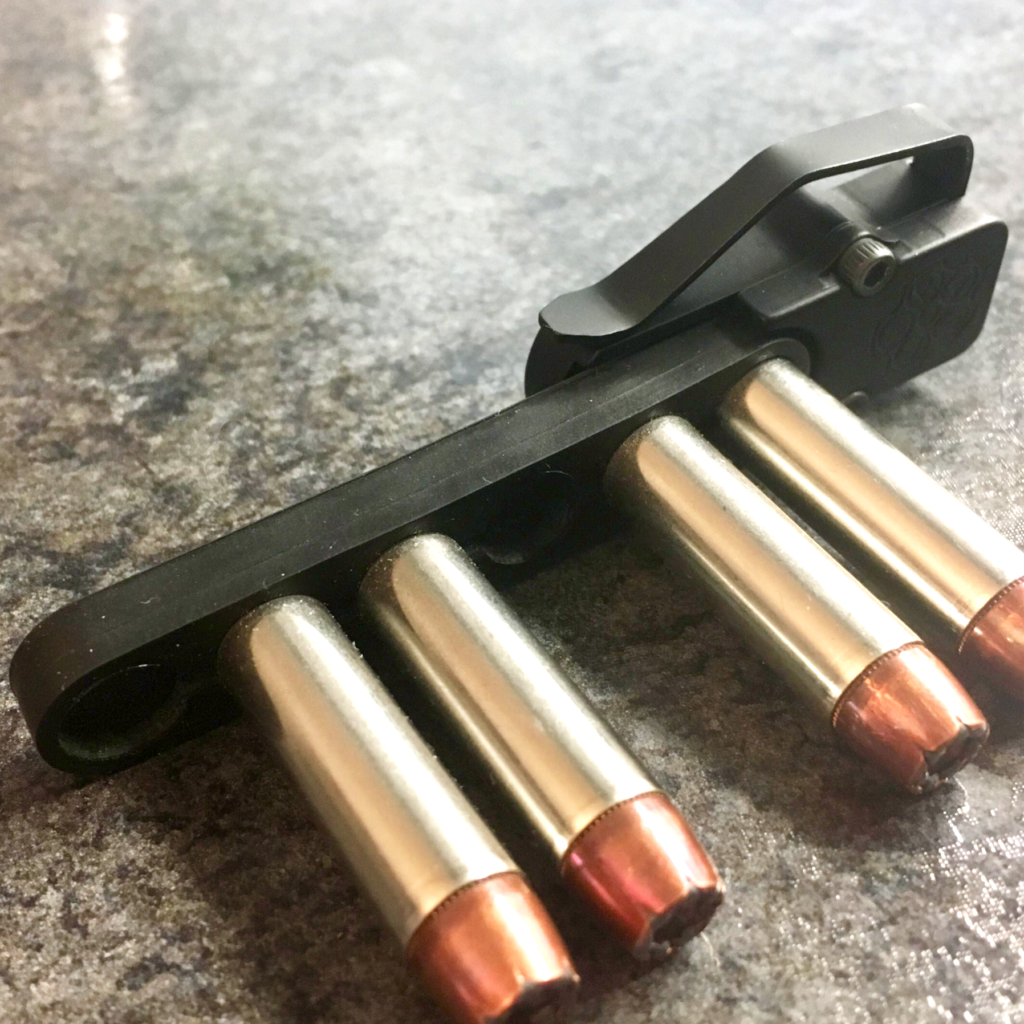
Carrying a strip-style loader in a pocket is certainly more convenient than carrying a round-body loader in one. The flat package doesn’t print as much, is more comfortable, and is less likely to accidentally discharge or lose rounds. Unfortunately though, pocketing a strip loader doesn’t solve the problem of the ammo being exposed to impact, water, and debris, and it also doesn’t solve the issue of inconsistent presentation. Plus, it’s typically slower than a round-body loader.
The elusive ideal
So, it seems the ideal solution would be to carry the round-body loader in a good pouch that would keep it properly oriented, protected, and concealed, as well as providing quick access.
That’s a lot easier said than done, though. With most speedloader pouches on the market, you can have some of these things, but usually not all of them at once. For example, my old standby—the metal CD-2 holder from Safariland—does a great job of keeping the loader aligned properly and allowing a fast draw, but it doesn’t provide much protection for the loader and the retention is poor. If I got into a scuffle, got hung up on a seatbelt, or jumped a fence, I’d probably lose the payload. Plus, it doesn’t conceal very well. Other pouches I’ve used have suffered from similar fates—they excel at some tasks, and suffer at others.
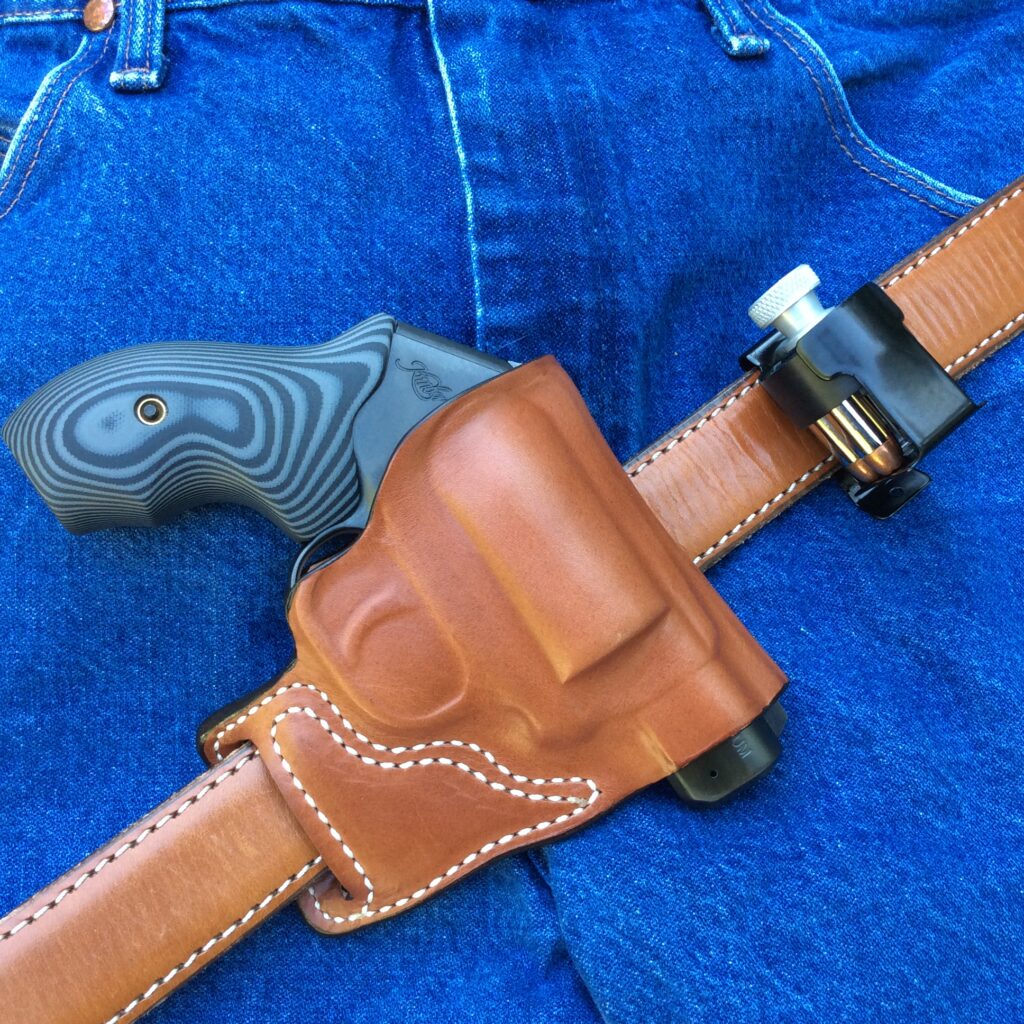
All of this recently led me to Don Hume Leathergoods, and their Pack Six speedloader pouch.
A household name—at least in the station house
For those of you who are new to the gun scene, Don Hume Leathergoods has been one of the reliable standbys in gunleather since “way back in the 1900s” (as some post-Y2K whippersnapper recently wise-cracked to me, when I was talking about something from my youth). When the revolver was still King and nearly every cop carried one on duty, Don Hume made a name for itself with its Bill Jordan-inspired duty holster, and the famous River gun belt that did such a great job of carrying it.
Starting in the early 1950s, Don Hume built a reputation as a maker of quality police leather that featured solid designs and execution. They’re still one of the top purveyors of police leathergoods today, but they’ve also embraced the armed citizen market as well. If you’re looking for a holster or accessory, you’d be hard-pressed to find gunleather of this quality, at the low price point Don Hume is known for.
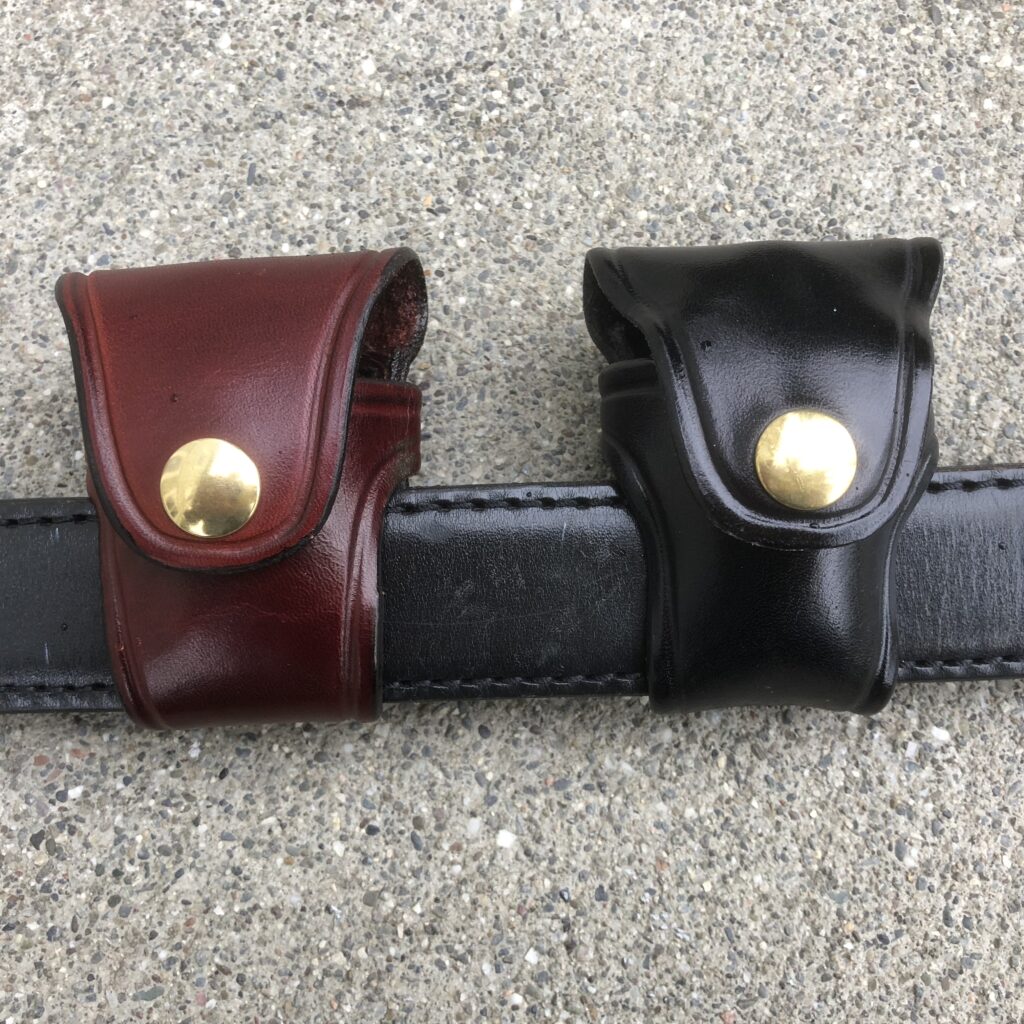
The Pack Six speedloader case we’ll examine here is a perfect example of that. It’s a no-frills, classic design that’s well-executed and reasonably priced. In fact, each of the two cases I purchased cost less than $20 before shipping and handling, which struck me as very reasonable, indeed.
Details
The Pack Six is a flapped carrier that allows you to carry the speedloader in such a manner that it straddles the top edge of the belt, with half the rounds in front of it, and the other half behind it. By allowing the belt to split the loader in this way, the whole package is less bulky and conceals much better than a cased loader that’s carried on the outside of the belt.
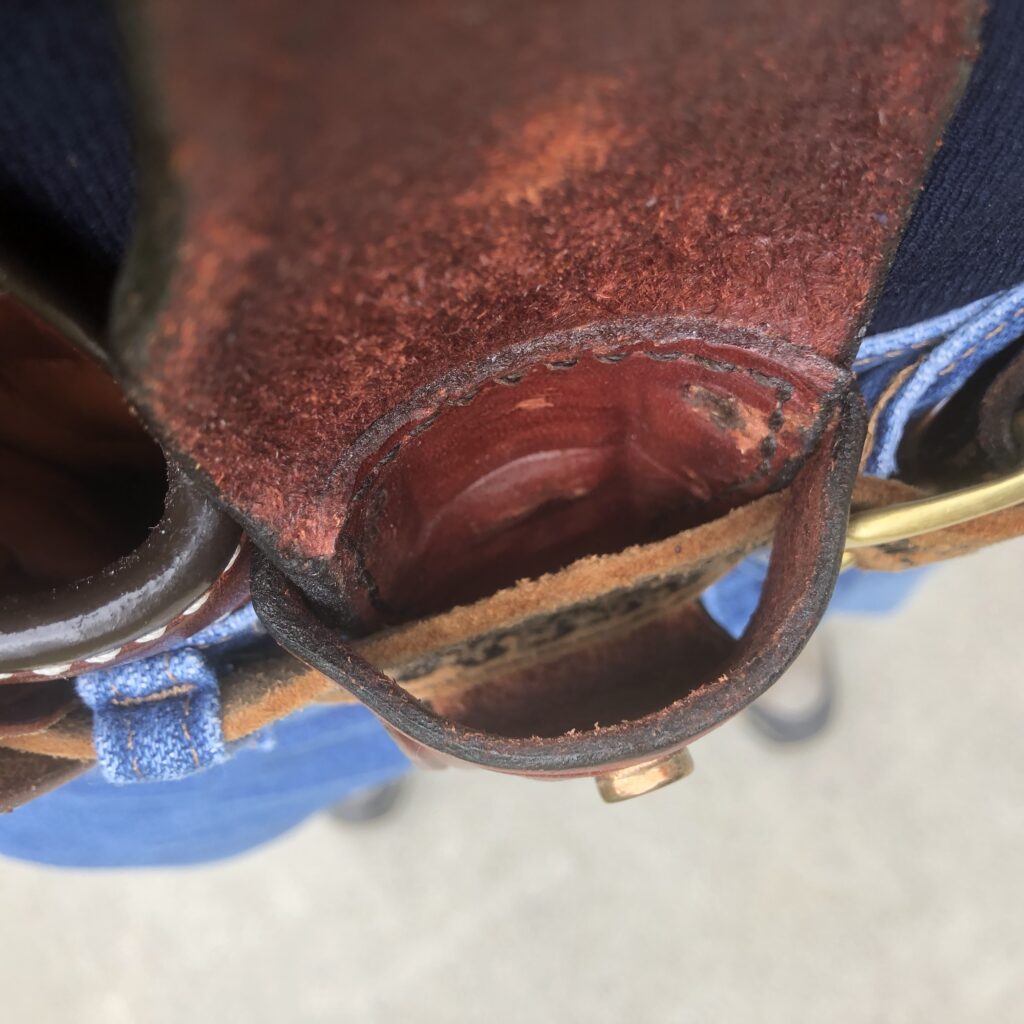
If you’ve been around the revolver scene for any length of time, the Pack Six design is a familiar one to you. It has its origins in a Bill Rogers design from the early 1980s (patented in October of 1983) which was so successful that it attracted the attention of Safariland, who worked out a royalty agreement with Rogers that latter blossomed into them purchasing his company.
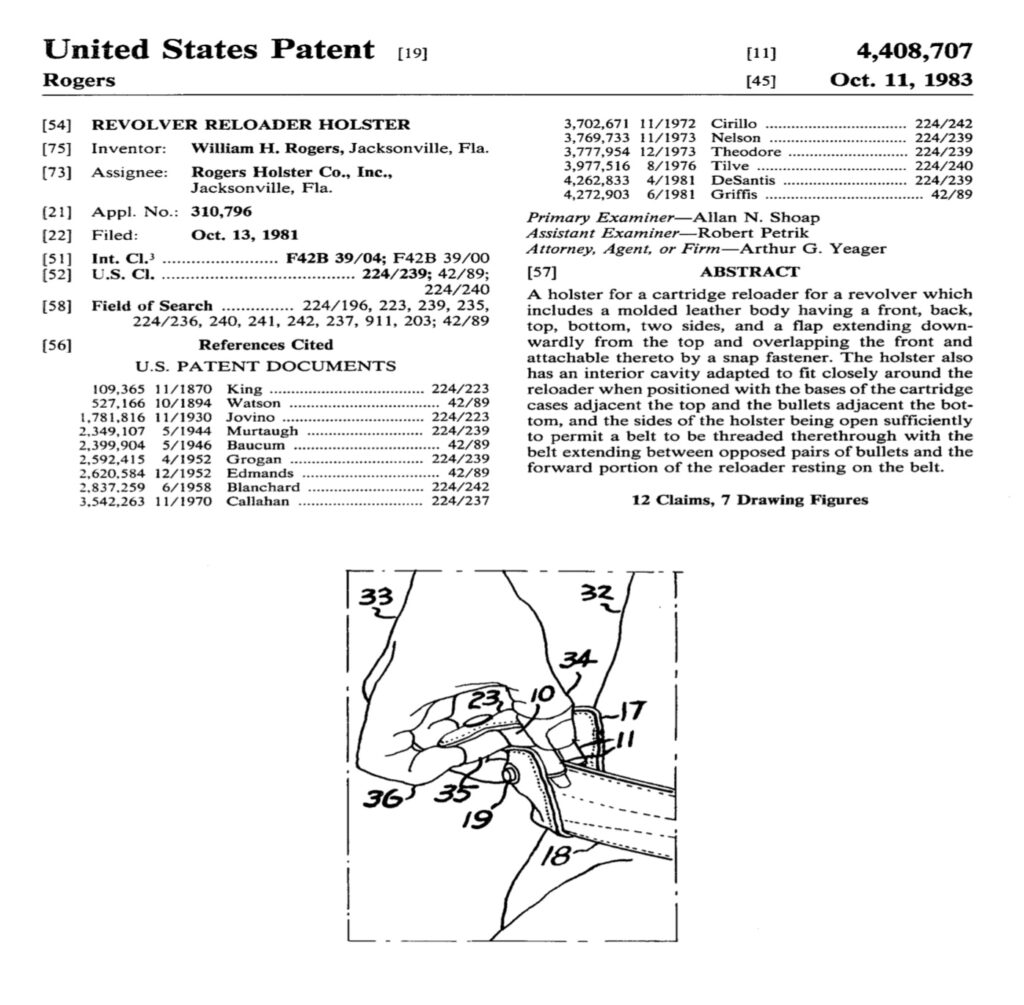
Rogers may have came up with the design, but we’ve seen similar models from just about everybody in the business, to include the now-discontinued Bianchi Agent Slim and Safariland Split-Six pouches, and the still-available DeSantis Second Six, AE Nelson #51, and Wild Bill’s Concealment speedloader pouches. Don Hume doesn’t have a unique claim on the basic design, but they can claim that their take on the concealable speedloader case is priced more competitively than the others, without sacrificing quality in materials or design.
Unlike DeSantis’ take on the split carrier, the flap on the Don Hume Pack Six does not have a window for the loader’s knob to poke through. This prevents you from using some of the loaders with tall handles or profiles (like the Jet Loader, Speed Beez, SLV, or Comp III), but it also offers full protection from sweat, debris and the elements, or from impacts which could accidentally discharge the loader while it’s still in the pouch. Additionally, it helps to prevent the loader from getting snagged on the opening in the flap when you draw it, as I’ve sometimes experienced with the other style.
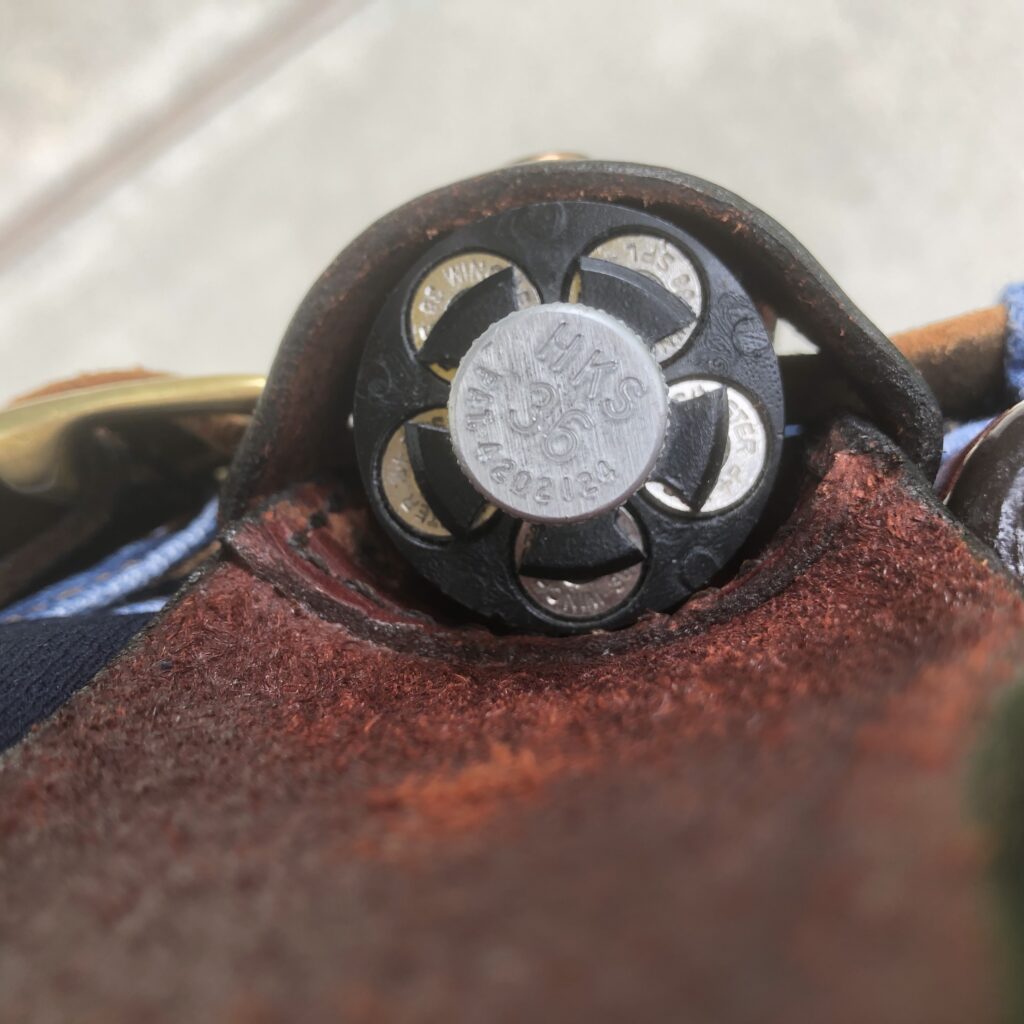
One limitation of the Pack Six–and others of its type—is that it’s best suited for loaders with a twist-knob release mechanism. The push-style loaders (like the excellent Safariland Comp series, or the elusive SLV) can sometimes discharge when carried in a split-style pouch, because the release mechanism in the central axis of the loader rides very close to the top edge of the belt (and sometimes even rests on it). It doesn’t take much pressure to push the loader down onto the top edge of the belt and accidentally discharge it. This can happen when you bump into something, or when you bend at the waist and your abdomen pushes down on the top of the pouch. It can also happen when you get hung up on a seatbelt, or in the process of drawing the loader from the pouch. The earlier Safariland Split-Six pouch incorporated recesses that were designed to hold the loader away from the top edge of the belt to prevent this, but even this wasn’t foolproof, as some coppers found out the hard way.
So, while Don Hume offers Pack Six fits for the various Safariland Comp loaders, it’s probably best reserved for twist-knob loaders like the classic HKS, or newer designs like the 5-Star or Pachmayr. That’s not a problem for me, since I grew up on a steady diet of HKS loaders, and enjoy working with them. However, if you’re a push-loader devotee, then you’re better off looking for another style of pouch.
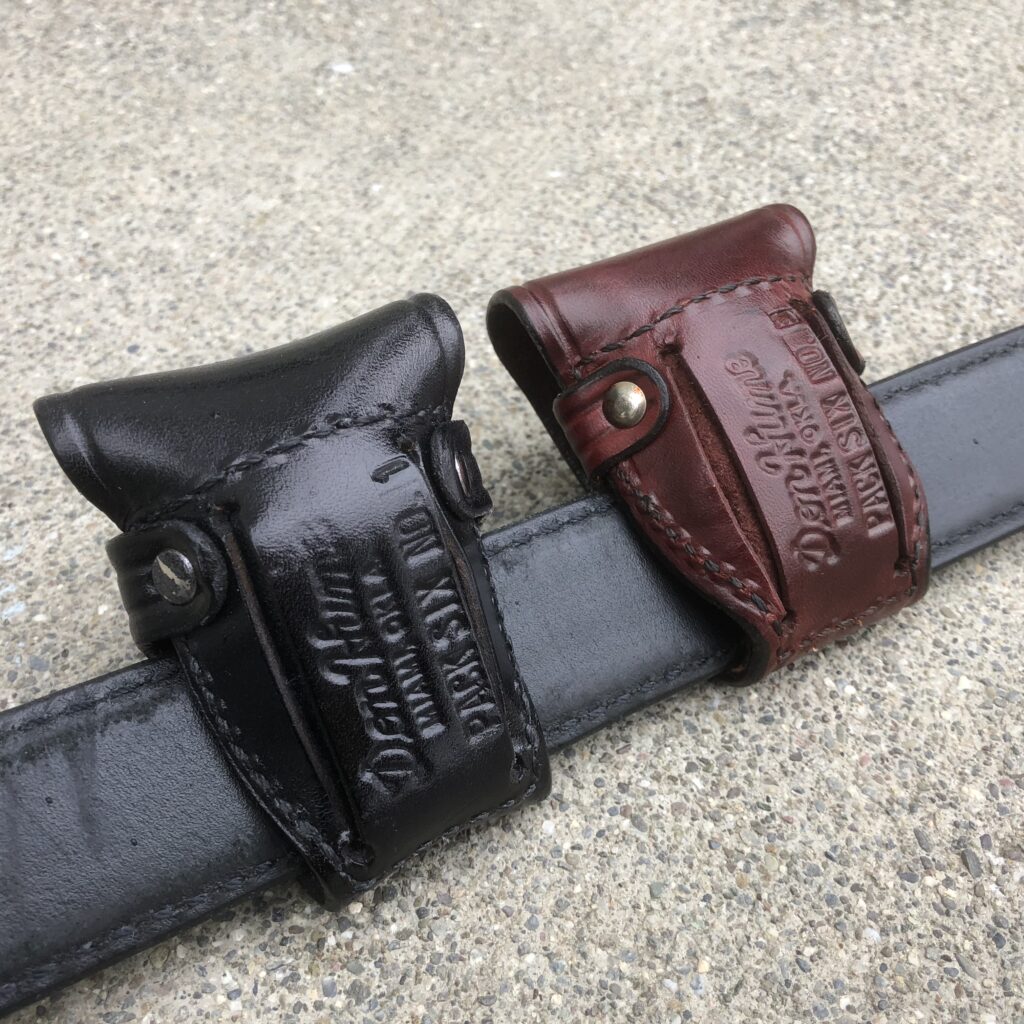
Actually, that’s not completely accurate. One thing that differentiates the Pack Six from other carriers of this type is that it has a belt slot on the back panel, which allows you to carry it on the outside of the belt like any slide-on accessory. This increases the profile of the package a little more, but it also allows you to carry a push-style loader without the risk of accidental discharge that you’ll incur by carrying it in a split fashion. None of the other split-style carriers do that, to my knowledge, and it’s a good option for those of you who want to use the Pack Six carrier, but aren’t willing to trade your beloved Comp II for an HKS.
Using the Pack Six
Because it doesn’t have an open top, the Pack Six takes a little more work to get to the loader. You’ve got to pop that flap and hold it out of the way to access the device, which takes longer than drawing from an open top style, but the tradeoff is that the loader is more likely to still be there after vigorous activity. You’re trading security for speed here, and only you can determine which side of that divide you’re more comfortable living on.
As I experimented with working the Pack Six, I tried two different methods of opening and retaining the flap so I could draw the loader.
In the first method, I popped the flap by coming underneath it with the outside edge of my thumb and sweeping it up. As the flap opened up, I trapped it against my body with the thumb, and acquired a grip on the now-exposed knob of the loader with my thumb, index finger, and middle finger on the downstroke.
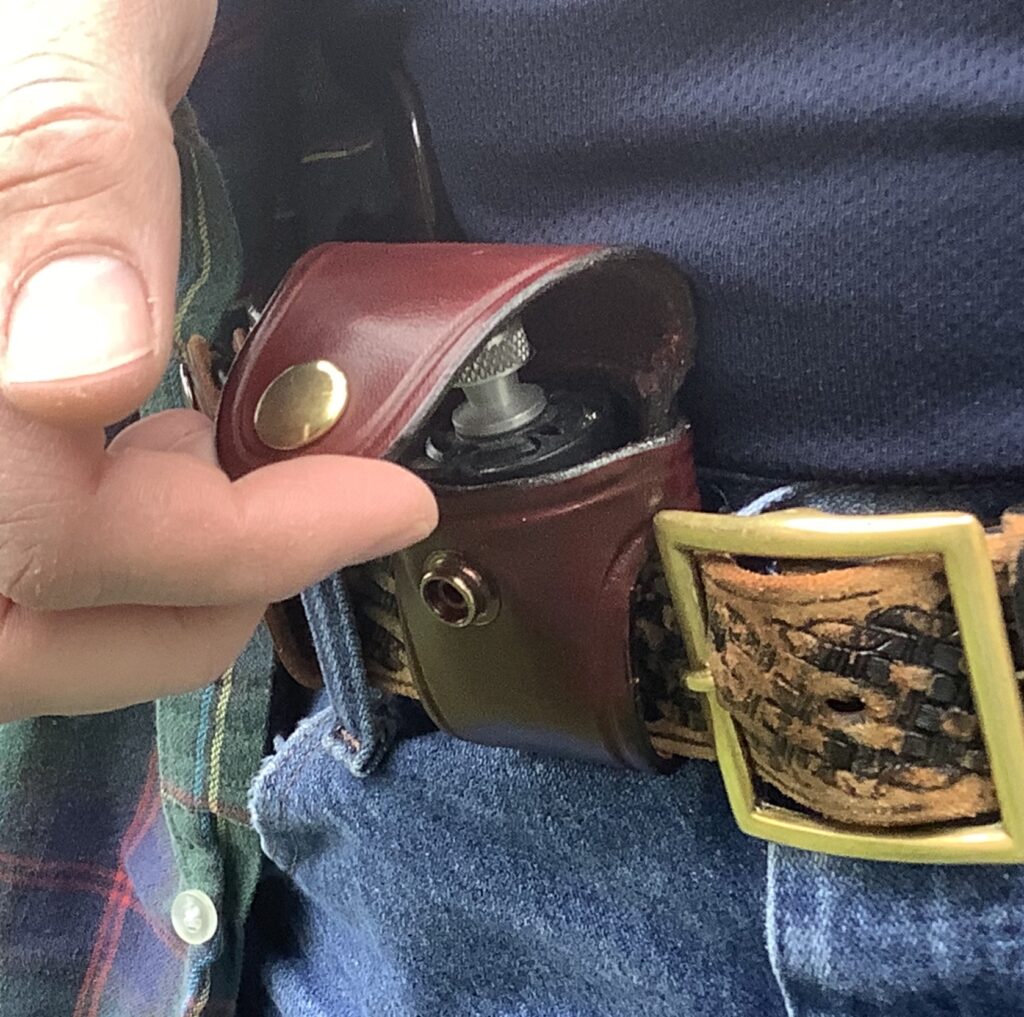
The second method was different in that I used the fingertips of my index, middle and ring fingers to claw open the flap and hold it against the body. On the downstroke, my thumb would trade places with the fingers, and hold the flap open as the thumb slid down into position to grip the knob of the loader along with the first two fingers.
This last method was much more reliable for me. I found that there wasn’t enough excess leather material below the snap to get a reliable purchase on the flap with the edge of my thumb, and sometimes it would skip off in a failed attempt. The fingertips were much more likely to get a good purchase and pop the flap the first time, so that became my go-to method of operating the Pack Six.
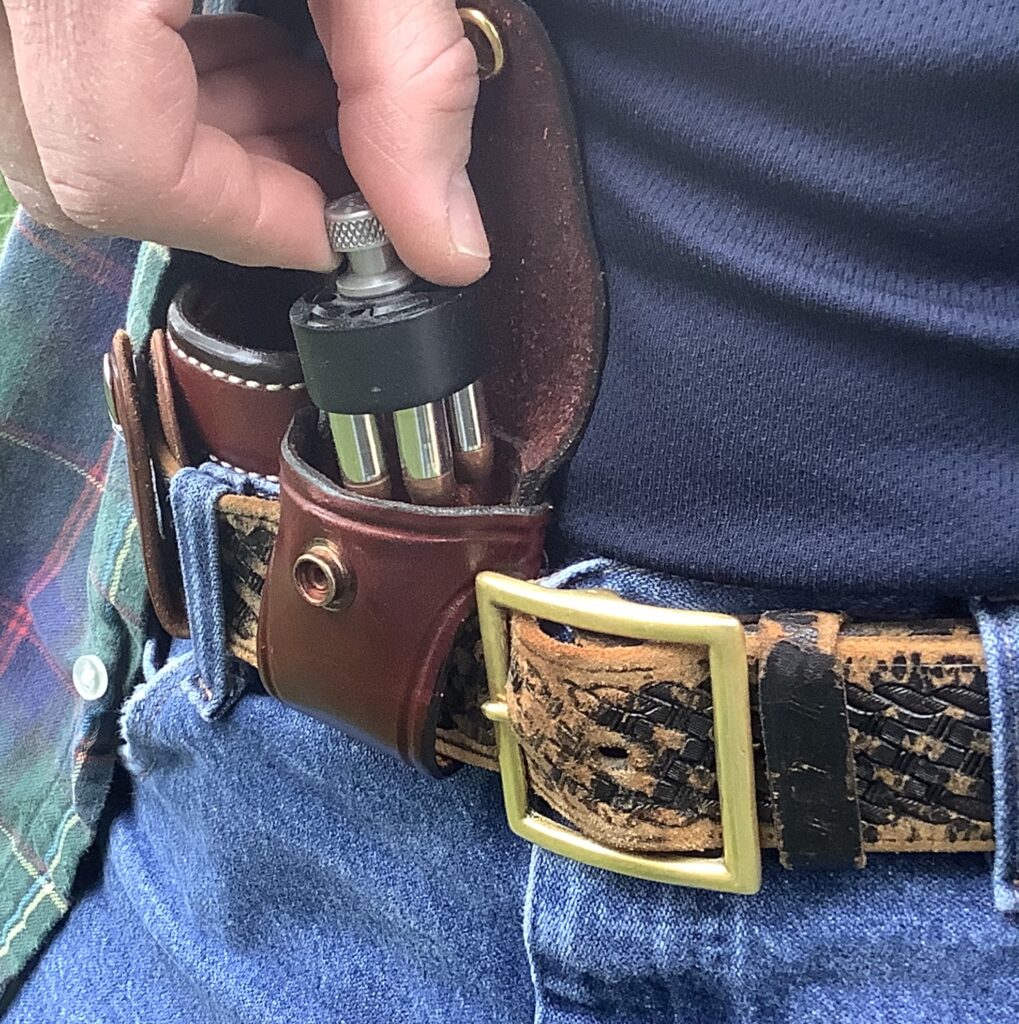
One limitation of the Pack Six is that the construction of the pouch doesn’t allow you access to the side of the loader body for establishing a grip. The only way to get the loader out of the pouch is to lift it out by the release knob—either all the way, or far enough that you can trade your grip on the release knob for a grip on the sides of the loader body. As I’ve previously discussed in these pages, I prefer to grip the loader on the sides of the loader body before I present it to the gun, so this is a real negative for me when using this pouch. Pulling the loader out by the release knob is the fastest way to use this pouch, but that can make it more difficult to index the cartridges into the chambers and you run an increased risk of accidentally discharging the loader when you pull it out. Trading your grip after lifting it out part of the way is a way to fix these issues, but the transition can be awkward and slow, and you risk fumbling the loader entirely.
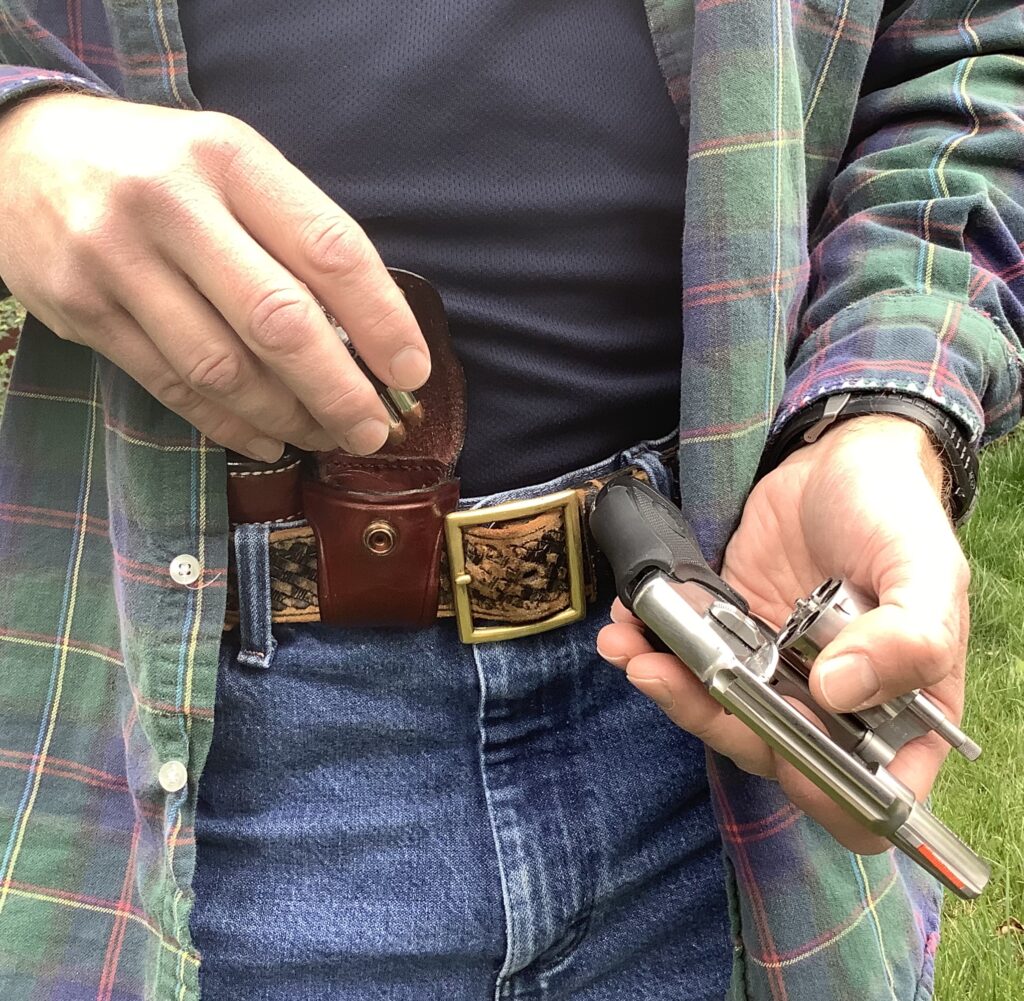
So, that’s my biggest criticism of the pouch. I could attempt to remedy this by cutting away the straps on the sides (which would make the loader more similar to the Safariland, Wild Bill’s and AE Nelson designs), but this would sacrifice the integrity of the pouch a bit. As a consequence, the pouch could sag or lean out away from the body, increasing the profile. Additionally, it wouldn’t hold the loader as securely.
There you go. Another tradeoff. You pays your money and you makes your choice.
Carrying the Pack Six
One thing that I really do like about the Pack Six is that it carries pretty flat. When I place the Pack Six ahead of my appendix inside-the-waistband holster, it takes advantage of the natural gap that’s created by the bulk of the cylinder. This significantly lowers the profile of the carrier on my belt, and it doesn’t stick out a whole lot more than the belt loops on my holster. As a result, the carrier and the gun conform pretty well to the curve of my body, and my shirt glides over them both without a tell-tale sign that anything is there.
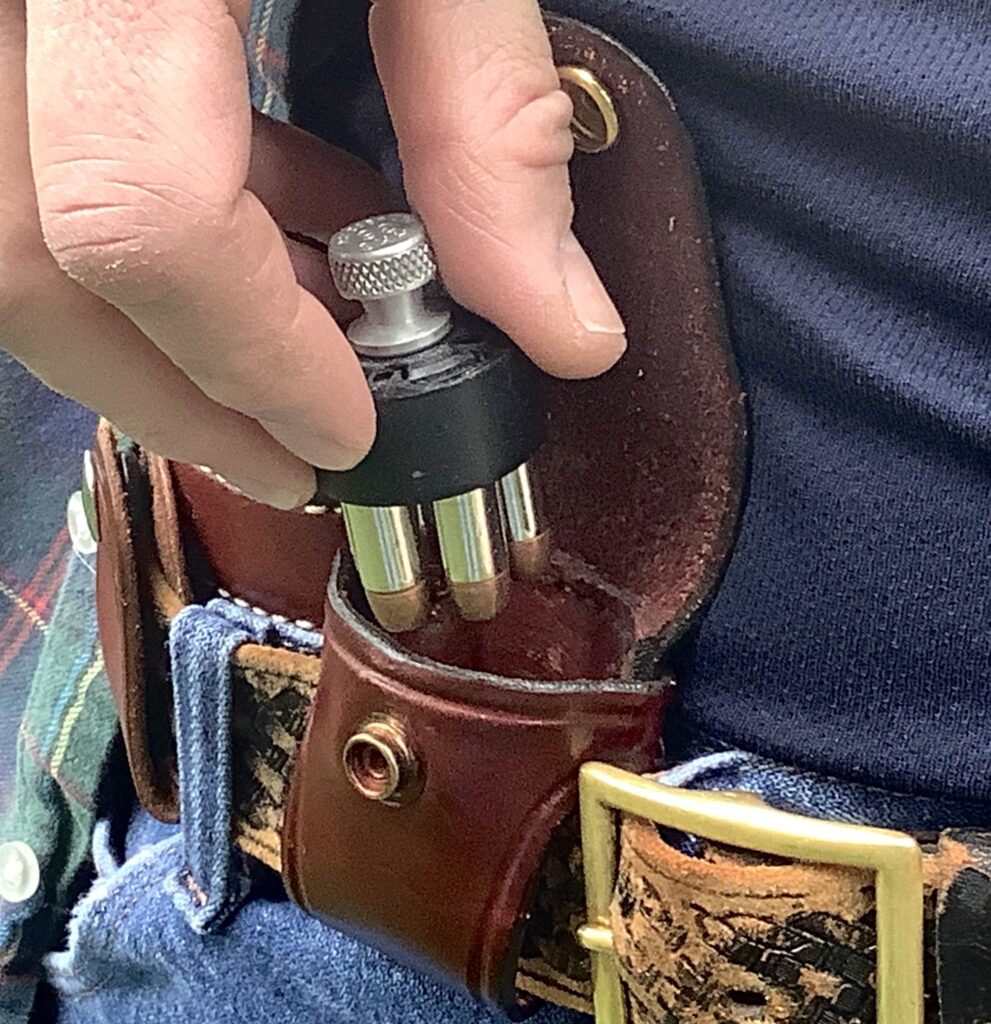
Placing the Pack Six ahead of the holster also locks it in place between the holster and the belt buckle, so it doesn’t slide around at all. This guarantees a consistent placement that aids in making a smooth draw. It’s also readily available to either hand in that location, should I be having a really bad day, and needing to access the pouch with my weak hand (yeah, I said it) as part of a one-handed reload.
Choices
Don Hume offers the Pack Six for a wide variety of loader styles and sizes, from the tiniest guns to the largest ones. You can choose from Black or Saddle Brown leather, and can also choose Brass, Nickel, or Black hardware. I ordered a J-Frame size in Saddle Brown and a K-Frame in Black, for easy identification.
Does the Pack Six represent my “ultimate” speedloader carrier? No, it doesn’t. I’d really like better access to the sides of the loader body for the draw, and I wouldn’t argue with having a little more leather south of the snap to get a better purchase on the flap, but in a battle of competing demands, it’s a pretty good choice.
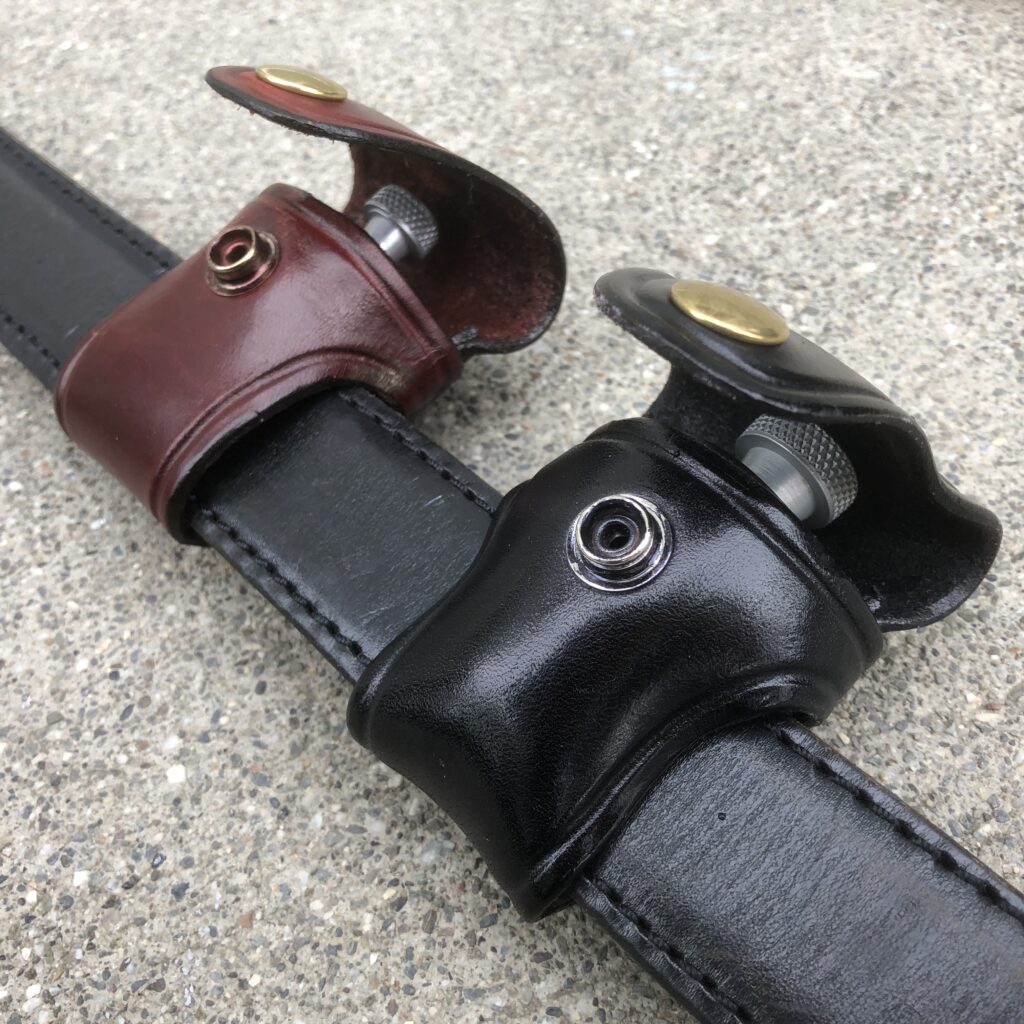
The Pack Six carries a round-body speedloader comfortably, securely and discreetly. It’s solidly built from quality materials and will last the rest of my life, and then some. It’s not the fastest rig out there, but I know that my HKS will be there when I reach for it, and I’ll be able to get it out with reasonable speed. I’m actually much more concerned about losing the loader from my belt in a struggle or during vigorous activity than I am with reloading on the clock anyhow, so the Pack Six seems like a reasonable tradeoff for me.
If that sounds like a good tradeoff for you too, I’d encourage you to give one a try. They’re inexpensive enough that it won’t cost much to give it a shot, and if you decide you don’t like it for concealed carry, you can easily repurpose it as an outside the belt carrier for hunting, woods bumming, or general field use. Barring that, you can use it as an air freshener for your truck, because nothing beats the smell of brand new gunleather, eh?
Be safe out there!

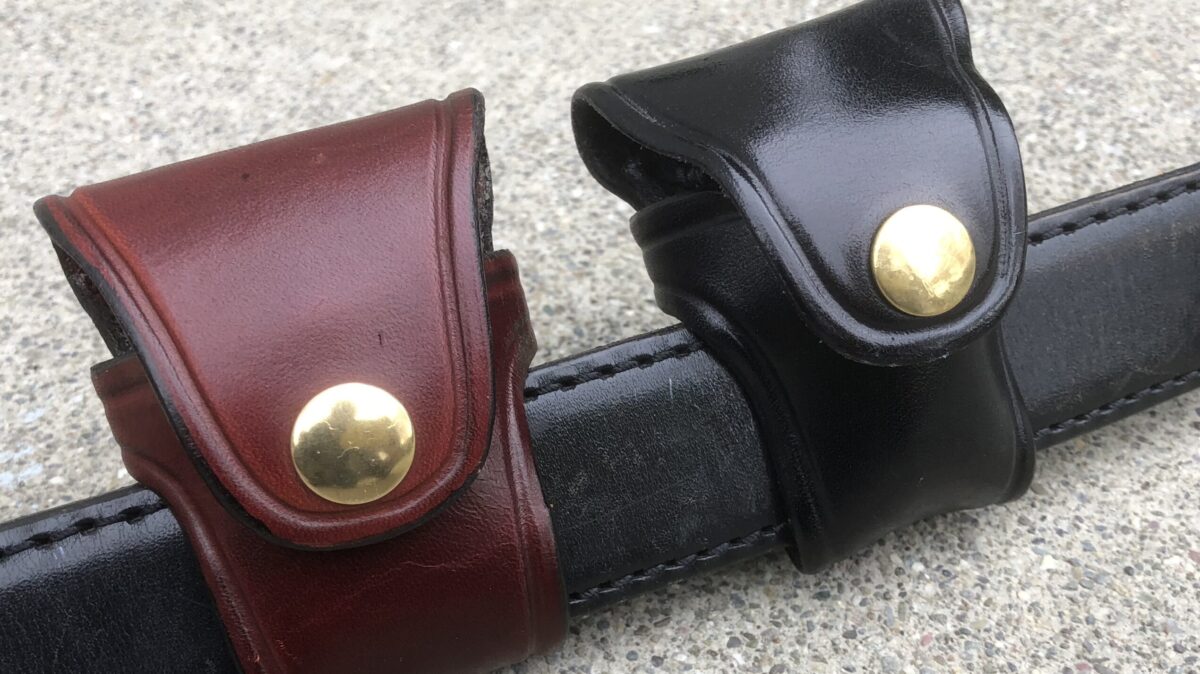
Great review. I have tried a lot of speed loader carriers. I can use – but am not a fan of – speed strips. The issue I have run into is how thick your belt is. I bought a Second Six for an HKS K-frame loader. It will not “split” the shells over my belt (leather 1.75 with internal steel reinforcement) and the flap barely snaps even with the tension screws set to the loosest position. I guess it’s time to try a Jox holder!
I can see how the overly-thick belt wouldn’t let the loader sit low enough to make the pouch work. If the difference is small, you could try soaking the pouch in water, then load it up and see if you can stretch it enough to close. It might take a few attempts to progressively stretch it out.
Also, don’t forget this Hume pouch has a slot in the back, so you wouldn’t have to split the belt with the loader. The only difficulty might be getting your very thick belt through the slots.
Just curious Mike, did you try the belt slots to see how well it conceals? I have comp II’s, hence the interest.
Thanks.
Jim, I ran the belt through the slots but found the pouch stuck out a little too much in the position where I wanted to wear it, up front. It would probably be acceptable for someone who wanted to wear the pouch in a different location, but up at 12:30 to 1:00 I thought it was much better with the belt run through the middle. I wear a magazine pouch at about 9:00 to 9:30 on the outside of the belt, and the bulk seems less noticeable here, because of how the shirt hangs. I suspect this pouch would ride the same–closer to the 3-9 line might be better if you want to use the slots.
Mike,
Thanks for the observations. Like you, and from my duty carry, back in the day, I like my speedloaders on strong side front, which for me would be 11:00-11:30. I’m what Justin would call wrong handed, but I’ve always called it being in my right mind. =) I forgive him tho. Thanks again and you guys keep up the great articles.
Thanks Jim! Yes, if you want to carry this pouch up front in concealment, I think you’ll be happier splitting the belt with it. However, there’s a lot of individual factors at play with body shape, clothing choices, etc., and you might find that it works just fine for you on the outside of the belt. It’s a difference of about half-an-inch of bulk. I’m a thin guy in a warm climate (therefore, lightweight fabrics) and I find the pouch sticks out too much for me if I use the loops, but it might be different for you, depending on the variables. Thanks for the support from the sinistral camp!
Hi Mike,
I went ahead and got one of these to try. Figured for the price I couldn’t go wrong and could still use it at the range if nothing else. Plus the company is kinda nostalgic for me.(My first duty holster was a Jordan style Don Hume😀)
When I tried it out, split, I couldn’t seat the comp 2 deep enough to snap. After some experimentation I found that due to the comp 2’s release type, it cannot seat completely with my 1.75″ belt but with my 1.5″ belt it will seat and close. Just wanted to pass the info along for anyone considering the Don Hume pouch with safariland loaders.
Of course using the belt loops there’s no problem with a 1.75″ belt.
Hope it is beneficial. 😀
Jim S
Thanks for the great info, Jim. I hope you’ll enjoy the pouch with your 1.5” belt! What did you think about using the belt slots for concealment at your 11?
Incidentally, my first duty holster was a Don Hume as well, but it didn’t have the panache of your Jordan!
I typically stay away from using push-feed loaders with this kind of pouch—seems like there’s too much of a risk of the loader accidentally discharging in the pouch. I have no such worries with the HKS style.
Unfortunately, I didn’t feel the belt slots conceal well for me, which slightly surprised me because I’m not in as good shape as I was in my 20’s. I’m in fairly good shape for 60 but I do have a slight bulge that helps my shirt hang looser from my waist. This still shows “something” under my shirt at 11. Maybe not recognizable but a small bump at my waist. I guess it would be ok for some. Of course it would be fine for winter, under a coat.
As far as split, after trying it out, I tend to agree with you on the push loaders. As much as I love my comp 2’s, and though I had no occurrences of accidental release, it causes one part of me to constantly wonder if it’s secure. I’m thinking I’ll wear it around the house and see how it does.
Don Hume used to make a split loader pouch specifically designed for safariland comp 2, but it was for 2″ duty belts. It was a double pouch with a leather edge the loader split over but there was a cutout for the plunger. This made the loader ride slightly higher. The model was D418. If you Google it you can find some pics. I actually own one and modified it similar to the Desantis second six by using a leather punch and two Chicago screws to fit my 1.75″ belt. Not so much for concealment of course, but great for range practice or outdoor activities.
I guess it’s not that important as it’s for my pre-lock S&W mod 10, 4″, but I’m one of those guys that has to have the accessories for every gun I own. I have a feeling you can relate. 🙂
Haha! Guilty as charged!